

Determining Viscosity of Blenderized Formula: A Novel Approach Using the International Dysphagia Diet Standardisation Initiative Framework - Weston - 2020 - Journal of Parenteral and Enteral Nutrition. Background Blenderized formula (BF) can be used in place of standard enteral formula and is composed of blenderized whole foods and purees.
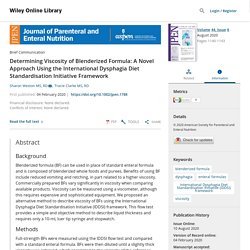
Benefits of using BF include reduced vomiting and retching, in part related to a higher viscosity. Commercially prepared BFs vary significantly in viscosity when comparing available products. Viscosity can be measured using a viscometer, although this requires expensive and sophisticated equipment. We proposed an alternative method to describe viscosity of BFs using the International Dysphagia Diet Standardisation Initiative (IDDSI) framework. Methods Full‐strength BFs were measured using the IDDSI flow test and compared with a standard enteral formula. Results IDDSI flow‐test results indicated that undiluted BFs ranged in viscosity, from slightly thick to extremely thick, when measured at room temperature. Conclusion The IDDSI flow test was simple to perform and can serve as a tool to determine the viscosity of BFs. Clinical Outcomes Associated With Commercial and Homemade Blenderized Tube Feedings: A Literature Review - Brown - 2020 - Nutrition in Clinical Practice.
Dispelling Myths and Unfounded Practices About Enteral Nutrition - Zoeller - 2020 - Nutrition in Clinical Practice. Enteral Nutrition Resources. General Resources NEW!
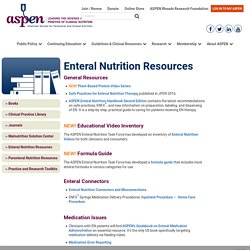
Educational Video Inventory. ESPEN guideline on home enteral nutrition - Clinical Nutrition. Recommendation 12 Until the stoma tract is formed and the incision is healed, the PEG exit site should be daily monitored and kept clean and dry by using aseptic wound care (usually up to 5–7 days post procedure).
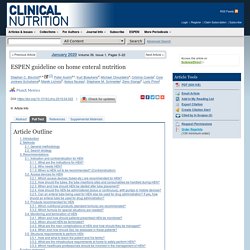
Grade of recommendation B – Strong consensus (100% agreement) Recommendation 13 A glycerin hydrogel or glycogel dressing should be used as an alternative to classical aseptic wound care during the first week(s). Grade of recommendation B – Strong consensus (97% agreement) Recommendation 14 After stoma healing, dressings can be reduced to one or two times a week, and the entry site can be cleansed using soap and water of drinking quality. Policy Statement - Blended Diet. Background The use of blended food administered into an enteral feeding tube is commonly referred to as following a ‘blended diet’.
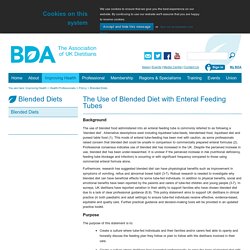
Alternative descriptions exist including liquidised tube-feeds, blenderised food, liquidised diet and pureed table food (1). This mode of enteral tube-feeding has been met with caution, as some professionals raised concern that blended diet could be unsafe in comparison to commercially prepared enteral formulas (2). Professional consensus indicates use of blended diet has increased in the UK. Despite the perceived increase in use, blended diet has been under-researched. Tutorial on Diarrhea and Enteral Nutrition: A Comprehensive Step‐By‐Step Approach - Pitta - 2019 - Journal of Parenteral and Enteral Nutrition. This tutorial suggests a current strategy toward a multiprofessional therapy based upon a comprehensive step‐by‐step approach to the course of intensive care unit diarrhea episodes.
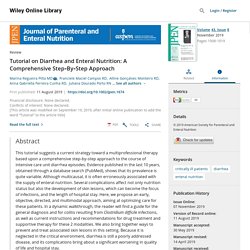
Evidence published in the last 10 years, obtained through a database search (PubMed), shows that its prevalence is quite variable. Although multicausal, it is often erroneously associated with the supply of enteral nutrition. Several complications affect not only nutrition status but also the development of skin lesions, which can become the focus of infections, and the length of hospital stay. Here, we propose an early, objective, directed, and multimodal approach, aiming at optimizing care for these patients.
In a dynamic walkthrough, the reader will find a guide for the general diagnosis and for colitis resulting from Clostridium difficile infections, as well as current instructions and recommendations for drug treatment and supportive therapy for these 2 modalities. Effect of Registered Dietitian Nutritionist Order‐Writing Privileges on Enteral Nutrition Administration in Selected Intensive Care Units - Arney - 2019 - Nutrition in Clinical Practice. Background Adequate nutrition is linked to improved patient outcomes during critical illness.
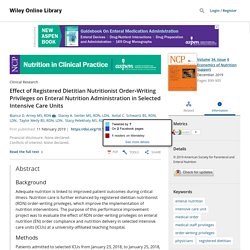
Nutrition care is further enhanced by registered dietitian nutritionist (RDN) order‐writing privileges, which improve the implementation of nutrition interventions. The purpose of this performance improvement project was to evaluate the effect of RDN order‐writing privileges on enteral nutrition (EN) order compliance and nutrition delivery in selected intensive care units (ICUs) at a university‐affiliated teaching hospital. Methods Patients admitted to selected ICUs from January 23, 2018, to January 25, 2018, were screened for eligibility. Results Fifty adult patients (150 EN days) were included in data analysis, with 93 patients (279 EN days) included in historical data. Conclusions RDN order‐writing privileges improved EN order compliance and significantly improved protein delivery in selected ICUs. Enteral Nutrition in the Mechanically Ventilated Patient - Allen - 2019 - Nutrition in Clinical Practice.
The Use of Jejunal Tube Feeding in Children: A Position Pape... : Journal of Pediatric Gastroenterology and Nutrition. What Is Known Jejunal tube feeding is increasingly becoming the standard of care for children in whom gastric tube feeding is insufficient to achieve caloric needs.
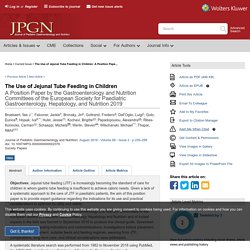
There is a lack of expert guidance regarding the indications and practical considerations to optimize its utility and safety in clinical practice. What Is New Jejunal tube feeding is a safe and effective means of enteral feeding when gastric feeding is insufficient to meet caloric needs. The decision to place a jejunal tube has to be made by a multidisciplinary team, working in close cooperation and providing active follow-up and care.
Jejunal tube feeding (JTF) is defined as postpyloric feeding through a feeding tube with its tip placed at least 40 cm distally to ligament of Treitz. ESPEN guideline on home enteral nutrition. Jejunal Feeding Bridges Parrish April 2019. Full Force Enteral Nutrition: A New Hope, or the Dark Side? A Critical Look at Enhanced Enteral Feeding Protocols. Nutrition support for adults: oral nutrition support, enteral tube feeding and parenteral nutrition. This guideline covers identifying and caring for adults who are malnourished or at risk of malnutrition in hospital or in their own home or a care home.
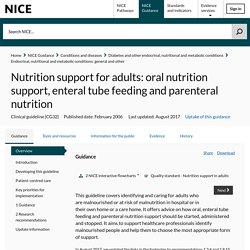
It offers advice on how oral, enteral tube feeding and parenteral nutrition support should be started, administered and stopped. It aims to support healthcare professionals identify malnourished people and help them to choose the most appropriate form of support. In August 2017, we updated the links in the footnotes to recommendations 1.3.4 and 1.8.15. Recommendation 1.7.17 was also updated and links added to National Patient Safety Agency documents. Recommendations This guideline includes recommendations on: Who is it for? Reemergence of Blenderized Tube Feedings. Evidence-based recommendations and expert consensus on enteral nutrition in the adult patient with diabetes mellitus or hyperglycemia.
Early enteral nutrition in critically ill patients: ESICM clinical practice guidelines. Question 11:Should we delay EN in patients with severe acute pancreatitis (SAP)?
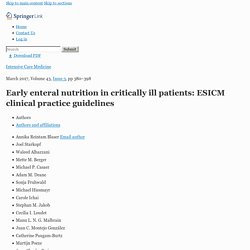
We identified five systematic reviews with meta-analyses comparing EN to PN while not considering timing (Supplement 5, Table 11B). All meta-analyses concluded that EN was beneficial in reducing infections and three reported reduced mortality [3, 34, 35]. We identified five RCTs addressing EEN (“early” as defined by the authors) vs. early PN in SAP whereas only two studies defined “early” as <48 h. Three further RCTs addressed EEN vs. early PN and one RCT EEN vs. delayed EN in “predicted SAP”. Two RCTs addressing acute pancreatitis independent of severity and one RCT studying mixed patients undergoing abdominal surgery were not included. We performed three separate meta-analyses all comparing EEN vs. early PN: (A) SAP and “early” as defined by the authors of the original study; (B) predicted SAP and “early” as defined by the authors of the original study; (C) predicted SAP and early defined as <48 h.
ASPEN Safe Practices for Enteral Nutrition Therapy. Calcium and Vitamin D Requirements of Enterally Fed Preterm Infants. American Geriatrics Society Feeding Tubes in Advanced Dementia Position Statement.